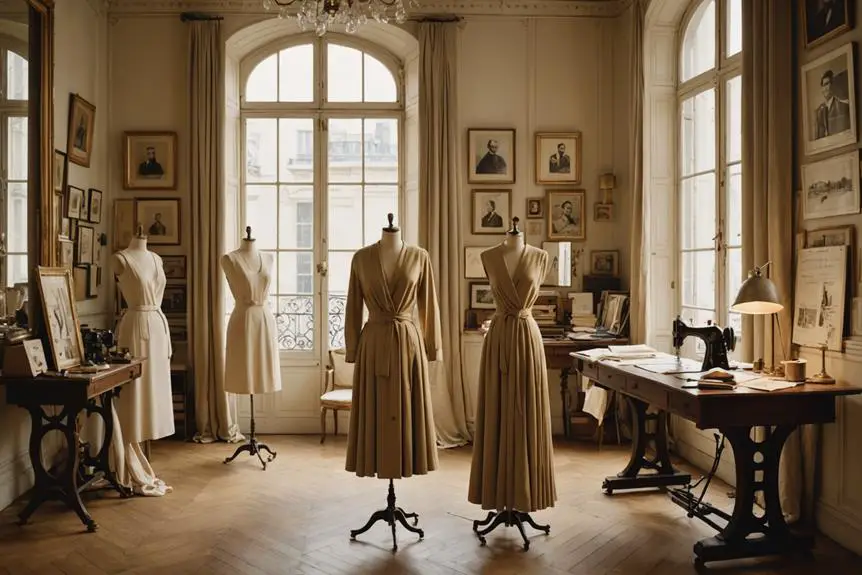The House of Celine, founded by Celine Vipiana in 1945, has a rich history that intertwines elegance and practicality in women's fashion. Starting as a made-to-measure children's shoe business, Celine quickly gained popularity for its luxurious leather goods, including shoes and handbags. By the 1960s, the brand expanded to ready-to-wear collections, solidifying its place in the luxury market. After being acquired by LVMH in 1996, Celine's influence soared globally. The brand's minimalist aesthetic and focus on craftsmanship continue to redefine modern femininity, making it a significant player in contemporary fashion. You might discover even more fascinating details about its journey.
Historical Roots of Celine

The surname Celine has a fascinating history that traces back to the Rhineland region of Germany. Originally, it emerged as a nickname derived from the German word "klien," meaning small. This name reflects the early practice of using single names in pre-medieval Germany, which eventually evolved into hereditary surnames as populations grew.
You can see how names like Cline became common variations over time, influenced by regional dialects and the lack of standardized spelling rules in those medieval days.
The first recorded instances of the Celine surname appeared in the 17th century, showcasing how this name began making its mark. One notable figure from this period is Daniel Klein, a Lutheran pastor, who contributed to the early reputation of the family. His work likely helped establish a sense of identity for those bearing the Celine surname.
As the centuries rolled on, members of the Celine family migrated to the United States, primarily between the 17th and 20th centuries. These early settlers established communities in states like Pennsylvania, Ohio, and Texas, bringing their heritage along.
The journey of the Celine surname reflects not just its origins but also the story of resilience and adaptation. Each twist and turn in its history has shaped the identity that many carry today.
Key Figures in Celine's Founding
Céline Vipiana stands as the pivotal figure in the founding of the House of Céline, having established the brand in 1945 with a clear vision. She aimed to create a line of elegant and practical women's fashion that combined functionality with high-quality craftsmanship. This focus on quality and style set Céline apart in the competitive world of fashion, especially as the brand became known for its distinctive vintage logo evolution that reflects its rich history.
Céline began by specializing in leather goods and luxury accessories, quickly gaining popularity for its made-to-measure shoes and handbags that catered to the needs of modern women. You could say she understood the pulse of her clientele, which allowed her creations to resonate deeply with them. This understanding was essential in shaping the brand's identity.
In 1960, Céline expanded its product range to include ready-to-wear collections, further solidifying its position in the luxury fashion market. This move not only diversified the brand but also showcased her commitment to evolving alongside women's changing lifestyles.
The brand's legacy grew when it was acquired by LVMH (Moët Hennessy Louis Vuitton) in 1996. This acquisition helped elevate Céline's global recognition and influence in the fashion industry, allowing her vision to reach a broader audience.
Through her dedication and innovative spirit, Céline Vipiana not only founded a brand but also established a lasting impact on women's fashion. Her journey exemplifies how passion and foresight can create a legacy that endures through generations.
Cultural Significance of Celine

Cultural significance surrounding the House of Céline stems from its ability to redefine modern femininity through fashion. Established in 1945 by Celine Vipiana, the brand originally became known for its minimalist and chic aesthetic, which perfectly captured the essence of Parisian luxury.
Starting as a made-to-measure children's shoe business, Céline reflected a commitment to craftsmanship and quality. This foundation laid the groundwork for the brand's evolution into women's ready-to-wear and accessories, much like how vintage Ralph Lauren items are characterized by their commitment to quality and distinct design.
The 1960s and 1970s marked a turning point when Céline became synonymous with modern femininity, attracting a devoted clientele of fashion-forward women. The innovative use of materials and clean lines in iconic pieces like the "Luggage" tote and "Triomphe" canvas products showcased the brand's unique identity, solidifying its place in luxury fashion.
Under the creative direction of Phoebe Philo from 2008 to 2018, Céline's cultural significance soared even higher. Philo emphasized a strong feminist ethos, transforming the brand into a cultural phenomenon that resonated with women seeking empowerment in their fashion choices.
Her collections celebrated individuality and practicality, making Céline not just a fashion label but a symbol of a new era for women.
Architectural Features of Celine House
Built in the mid-19th century, the Celine House showcases the elegance of Greek Revival architecture with its simple two-story, three-bay structure that emphasizes symmetry and proportion. As you approach, you can't help but notice the distinctive front porch that invites you in, a hallmark of Greek Revival homes. This architectural feature not only enhances the facade but also provides a welcoming entrance for visitors.
Spanning approximately 1,000 square feet, the house was originally designed for a family of four, perfectly balancing functionality and style. Notably, while the exterior reflects its Greek Revival roots, small sections of the original log cabin construction are still visible through Plexiglas near the front door, reminding you of its historical significance. This unique feature gives a glimpse into the past, connecting the present with the home's early days.
The Celine House has undergone significant renovations to preserve its historical integrity while adapting to modern needs. With central heating and air conditioning now installed, it stands as a fine example of how historical homes can evolve without losing their charm.
Recognized as a State Historical site, the Celine House not only represents an architectural style but also serves as a reflection of the craftsmanship of its era. When you explore this beautiful structure, you're not just witnessing a house; you're stepping into a living piece of history that continues to tell its story.
Legacy and Preservation Efforts

Preservation efforts surrounding the House of Célines reflect a community's commitment to honoring its historical roots. Located in Cline, Texas, this remarkable site has seen significant restoration initiatives aimed at maintaining its integrity and connection to the area's early settlement. Over the years, local residents have come together to highlight the contributions of pioneers like Celeste Pingenot and August Cline—individuals who later became integral to the region's development.
In 1982, the Pingenot home gained recognition when it was featured in the Uvalde Heritage Homes publication, showcasing the importance of preserving local heritage. This recognition spurred further community engagement, rallying efforts to protect not just the House of Célines but also the spirit of early Texas ranching culture.
Despite facing challenges such as a decline in population and services, the community's dedication hasn't wavered. Local heritage organizations continually emphasize Cline's historical significance, facilitating educational programs and events that raise awareness of the area's rich cultural legacy.
Through these initiatives, residents guarantee that the stories and traditions of their ancestors are celebrated and remembered.
Cline isn't just a waypoint for travelers; it stands as a monument to resilience and community spirit. As you explore the House of Célines, you're not only witnessing history but also participating in a legacy that thrives through collective passion and commitment to preservation.




